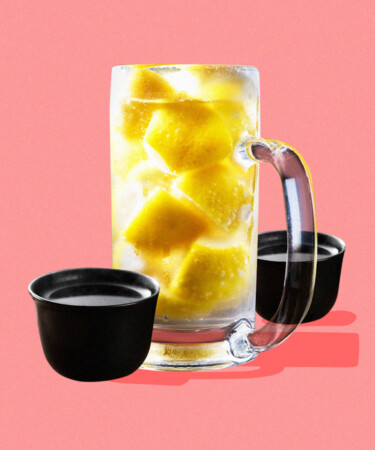Many international spirits make their introduction to American drinking culture by way of cocktails, regardless of how they are typically consumed in their place of origin. With the rising popularity of Asian spirits and cocktail bars within the U.S., shochu, a Japanese spirit that can be distilled from a number of starches, is quickly becoming American bartenders’ latest trick up the sleeve.
IWSR Drinks Analysis identified a rise of no- or low-alcohol products in cocktails as a key trend for 2022. As a spirit that typically falls between 25 and 30 percent ABV, shochu certainly fits into that trend. As such, with its gentler bite, the first consideration for many bartenders is how to carefully spotlight it within a drink.
“I’m generally looking at softer flavors and ingredients to use that won’t overpower or hide the shochu,” says Cameron Winkelman, head bartender of Manhatta in NYC’s Financial District. “Shochu can add some amazingly delicate, round layers of umami, and you don’t want to cover that up. Stirred or shaken, I generally keep it light and bright.”
Andy Lau, bar manager of Brooklyn’s The Hidden Pearl, points out that different variations of shochu bring their own unique nuances to a cocktail. “I always consider the base ingredient of the particular shochu style: sweet potato, barley, or rice,” he says, “since each style has its own characteristics and flavor profile.” On a similar note, Melissa Brooke, bar director of SoHo’s newly open speakeasy PS, likes to accentuate the unique flavors of different shochu expressions. “If it’s been distilled from sweet potatoes, I can see playing around with bourbon and building upon that baking spice foundation,” she says.
Many bartenders also find that shochu plays well with other spirits as a split base, or can add seasoning and roundness to a drink. “It goes well with vodka and non-aggressive gins, and also some softer, blended Japanese whisky or Scotch,” says Greg Wasserman, Miami-based bartender and former head bartender of NYC’s NoMad Bar. “These categories still allow the shochu to be present in flavor.” Lau, on the other hand, suggests combining shochu with various eaux de vie or even aquavit.
Perhaps shochu’s greatest potential, given its nuance, is as an ingredient in umami-forward cocktails. Lau includes two savory shochu-based cocktails on his list featuring shiitake mushroom and green peas, respectively.
“Umami is etymologically Japanese, so why not combine ingredients and flavors with spirits from the same place?” says Brooke. “Also the koji, which must be present in the making of shochu, is the very same one that is part of the production of miso and soy,” lending itself naturally to experimenting with savory flavors. Winkelman doubles down on the miso and soy sauce recommendation and also suggests “other traditionally savory ingredients, like nutty browned butter or toasted black sesame.”
As for ordering cocktails that lead with shochu, the consensus is that most American consumers are open to it — especially when doled out by respected bars and bartenders. “These days, I don’t find many patrons to be as skeptical or unwilling to branch out as they have been in the past”, says Brooke. “I think if a cocktail menu is easy to read — if they look at a cocktail and can identify most or all of the other ingredients — then they’re usually game to try something new.”
